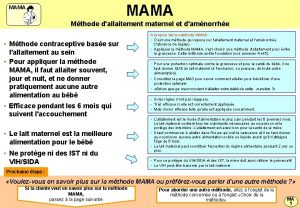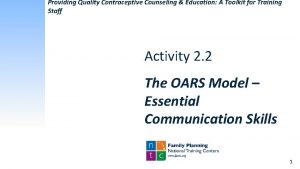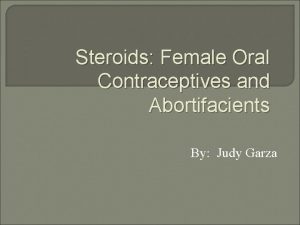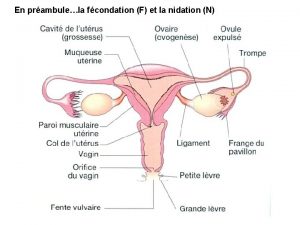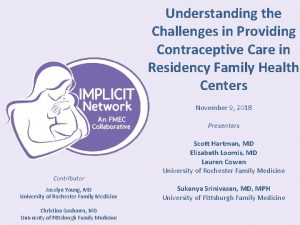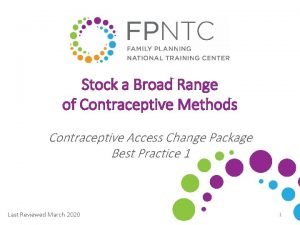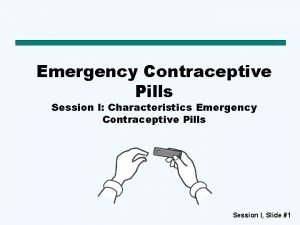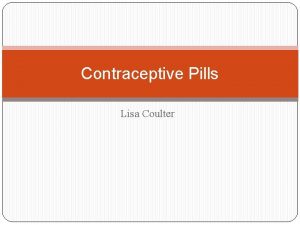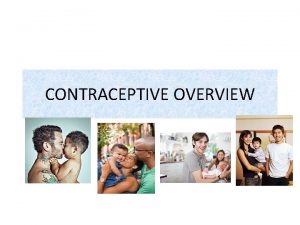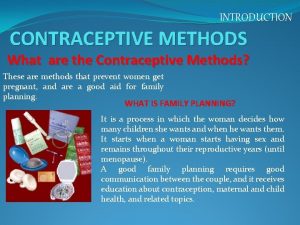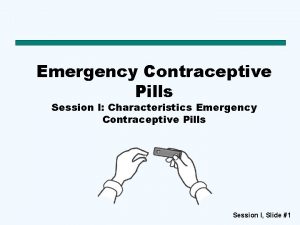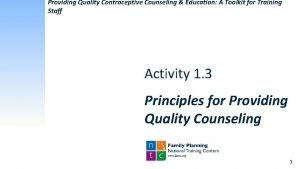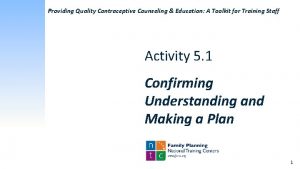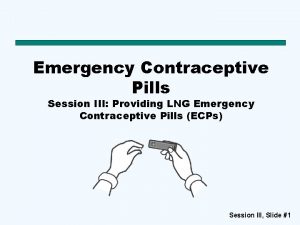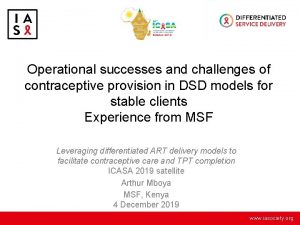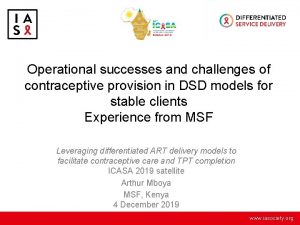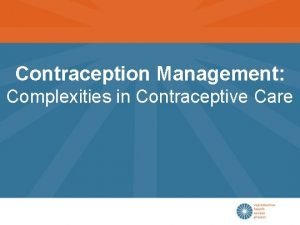Understanding the Challenges in Providing Contraceptive Care in



















- Slides: 19

Understanding the Challenges in Providing Contraceptive Care in Residency Family Health Centers November 9, 2018 Presenters Contributor Jocelyn Young, MD University of Rochester Family Medicine Christina Gasbarro, MD University of Pittsburgh Family Medicine Scott Hartman, MD Elizabeth Loomis, MD Lauren Cowen University of Rochester Family Medicine Sukanya Srinivasan, MD, MPH University of Pittsburgh Family Medicine

What is Interconception Care? An emerging concept for focusing on White lettering on from a color the health of a woman the postpartum period upeffective until her block is especially subsequent for catchingconception. attention and for retention.

Why Interconception Care? • Despite traditional prenatal interventions, low birth weight and prematurity have not decreased • Preterm birth (PTB, <37 wks) is the #1 cause of neonatal mortality & morbidity • Causes 50% of all pediatric neurodevelopmental problems • Low birthweight (LBW, <2500 g) is being linked to adult morbidities • CAD, DM 2, obesity • Preconception & interconception health increasingly being linked to preeclampsia, GDM, hemorrhage, and other perinatal complications

Key Components of the ICC Model developed by the IMPLICIT Network Integrate ICC into practices by screening mothers who accompany their children (under 2 years of age) to well child visits Target modifiable risk factors: 1) Smoking 2) Depression 3) Multivitamin with folate supplementation 4) Contraception birth spacing use to ensure adequate Collect and assess data using continuous quality improvement techniques (CQI)

Comparing IMPLICIT Interconception Care Data: Contraception Use to ensure adequate birth spacing Looking at LARC Rates between the two sites Presented at STFM Conference May 3, 2016 by Scott Hartman MD and Sukanya Srinivasan MD, MPH

Long Acting Reversible Contraception • 60. 9 million Women aged 15 -44 in the U. S. • 38. 3% not using contraception (Reasons include never sexually active, currently pregnant/seeking pregnancy (5%), infertility, etc. Women who had sex in the past 3 months who were not using birth control are 6. 9% of all women 15 -44). • 7. 2% using LARC (6. 4% IUD, 0. 8% Implant) • 20. 6% permanent sterilization methods • 33. 9% all other methods (16% Pill, 9. 4% Condoms, 2. 8% Depo, 1. 6% ring or patch, 4. 1% options such as natural family planning, female condom, etc. ) • LARC Rates by Race/Ethnicity: • Used by 8. 7% of Hispanic women aged 15 -44 • 7. 4% of Non-Hispanic White women 15 -44 • 5% of Non-Hispanic Black women 15 -44 • 5. 8% of all other single race or mixed race Preferred method of birth spacing for ICC

Diverse Settings: • University of Rochester Highland Family Medicine (HFM) • Family medicine and residency training practice in Western NY State • Serve diverse population of varying ethnic & socioeconomic backgrounds • Screened 1312 unique mothers at 2638 WCVs for ICC • LANGUAGES SPOKEN: Somali, Spanish, Mandarin, Arabic, Farsi • University of Pittsburgh Family Medicine Residencies (UPMC St M) • • Three health centers in south western Pennsylvania Serve diverse largely urban underserved population Screened 849 unique mothers at 3, 108 WCVs for ICC LANGUAGES SPOKEN: Somali, Vietnamese, Spanish, Japanese

Percent of Well Child Visits Mothers are Using LARC 100 90 80 70 Percent 60 50 40 30 20 10 0 Newborn 2 Month 4 Month 6 Month HFM (May 2015 - February 2016) 9 Month 12 Month 15 Month 18 Month UPMC (February 2015 - February 2016) 24 Month

Implementation of Evidence-Based Interconception Care Program: Barriers to contraceptive care access Looking at staff and clinician perceptions of challenges to providing contraceptive care between the two sites FMEC Conference November 9, 2018

Patient Visit Desiree is a 22 -year-old mother of two children – Maya (18 mo) and Shane (4 mo). She is here for Shane’s 4 -month WCC. • Smoking – current smoker (1/2 ppd x 5 years) • Depression – negative PHQ 2 • Family Planning – feels overwhelmed at home and does not desire to have another child in the next few years • Multivitamin – does not take a multivitamin but has leftover prenatal vitamins at home

Discussion What barriers to providing contraception care have you identified? Can you think of ways to manage these barriers at your health center?

Participant Demographics Staff • 76 participants • 93% female • 67% white, 19% black, 4% Latino, 7% mixed or other, 3% Asian HFM St. Margaret Providers • 95 participants • 56% female • 82% white, 13% Asian, 3% mixed or other, 1% black, 1% Latino HFM St. Margaret

Perceptions of Patient Barriers

Average Ranking Score Staff Identified Barriers Potential Staff Barrier to Providing Contraception Care Highland Family Medicine St. Margaret

Average Ranking Score Provider Identified Barriers Potential Provider Barrier to Providing Contraception Care Highland Family Medicine St. Margaret

Contraception Knowledge

Future Directions • Disseminate study findings – Presented results to HFM’s ICC Committee (January 12 2018) – Poster presentation at 2018 STFM Conference (May 6 2018) • Scheduling – Development of tracking system to follow-up on patients requesting LARC at St. Margaret • Education – Contraception didactic activity for staff at HFM (May 10 2018) • Focus Group – HFM 3 rd year resident focus group surrounding reliable availability of LARC devices (April 6 2018) • Quality Improvement projects – To be determined

Conclusions • Clinician-identified barriers: appointment timing. • Clinician perception of patient barriers: side effects and patient lack of awareness or misconceptions regarding contraception. • Staff-identified barriers: scheduling and finance. • Staff perception of patient barriers: o St. Margaret (side effects and patient lack of awareness or misconceptions regarding contraception). o HFM (transportation, though rated many other factors). • There is a significant gap in staff knowledge about IUD contraception.

Questions?
 Mama methode contraceptive
Mama methode contraceptive Oars communication
Oars communication Contraceptive
Contraceptive Contraceptive
Contraceptive Mode d'action de la pilule contraceptive
Mode d'action de la pilule contraceptive Neten contraceptive
Neten contraceptive Providing improper or unprofessional treatment or care
Providing improper or unprofessional treatment or care Providing improper or unprofessional treatment or care
Providing improper or unprofessional treatment or care Primary secondary and tertiary health care
Primary secondary and tertiary health care Nguyên nhân của sự mỏi cơ sinh 8
Nguyên nhân của sự mỏi cơ sinh 8 Một số thể thơ truyền thống
Một số thể thơ truyền thống Trời xanh đây là của chúng ta thể thơ
Trời xanh đây là của chúng ta thể thơ Số nguyên tố là
Số nguyên tố là Tỉ lệ cơ thể trẻ em
Tỉ lệ cơ thể trẻ em Phối cảnh
Phối cảnh Các châu lục và đại dương trên thế giới
Các châu lục và đại dương trên thế giới Thế nào là hệ số cao nhất
Thế nào là hệ số cao nhất Hệ hô hấp
Hệ hô hấp Tư thế ngồi viết
Tư thế ngồi viết Hát kết hợp bộ gõ cơ thể
Hát kết hợp bộ gõ cơ thể
